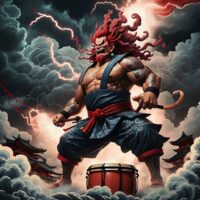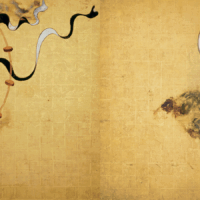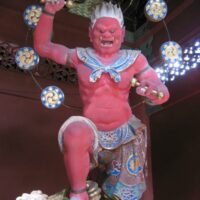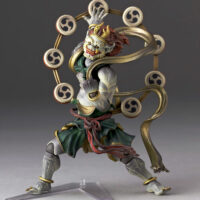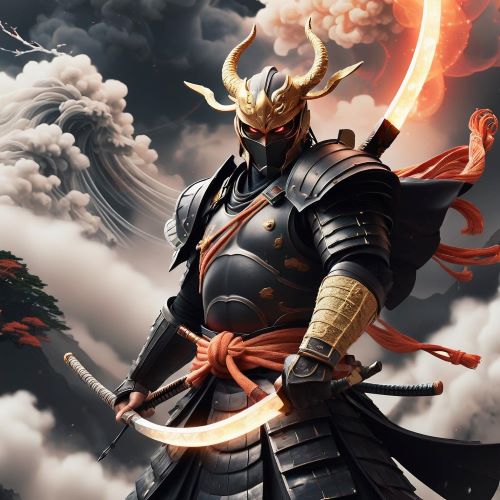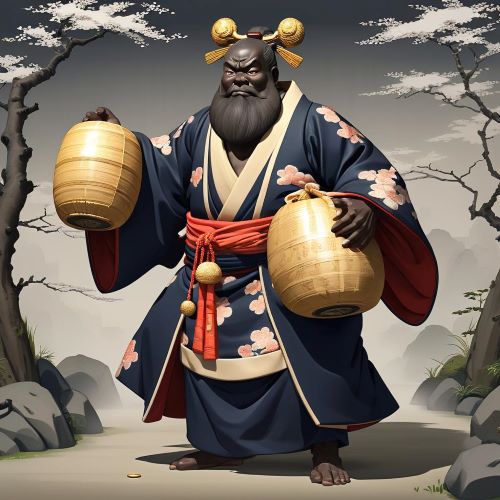Raijin : God of Thunder
Listen
At a glance
| Description | |
|---|---|
| Origin | Japanese Mythology |
| Classification | Gods |
| Family Members | Izanami (Mother), Fujin (brother) |
| Region | Japan |
| Associated With | Thunder, Lightning |
Raijin
Introduction
Raijin, the god of thunder, lightning, and storms, stands as one of the most powerful deities in Japanese mythology. His very name, meaning “Thunder God,” captures his essence as both a destructive and life-giving force. Originating in Shinto belief but also incorporated into Buddhist traditions, Raijin embodies the uncontrollable aspects of nature that both terrify and sustain humanity. His role goes far beyond the spectacle of thunder; he represents divine justice, agricultural fertility, and the balance between chaos and protection. Often paired with his brother Fūjin, the wind god, Raijin appears as a guardian in temples, a cautionary presence in folklore, and a recurring archetype in modern Japanese identity. In a country where storms and typhoons have shaped the rhythm of life for centuries, Raijin’s importance has never waned.
Physical Traits
Raijin is almost always portrayed as a formidable and intimidating figure. His body is muscular, accentuating his raw, supernatural strength, while his hair bursts outward like lightning itself, defying all order. Many depictions paint his skin in vivid red or deep blue, signaling his elemental nature and fiery temperament. Fangs and sharp claws add to his demonic aura, often likening him to an oni, yet his divinity sets him apart as more than a monster.
The most distinctive element of Raijin’s imagery is the ring of taiko drums encircling him. With every strike, thunder rolls across the heavens, echoing his anger or blessing the land with rain. These drums frequently bear the tomoe, a swirling comma-like symbol, which represents motion, energy, and eternal cycles. His attire is usually simple, sometimes including a tiger-skin loincloth, a nod to his primal association with storms and wild nature. In many works of art, Raijin is depicted riding dark clouds, surrounded by flashes of lightning, an unmistakable image of Japan’s tempestuous skies.
Family
Raijin’s genealogy ties him to the origins of the Japanese cosmos. He is traditionally described as a child of Izanagi and Izanami, the primordial deities credited with creating the islands of Japan. Born during the tragic death of Izanami after giving birth to the fire god, Raijin carries a symbolic link to death and the underworld, reinforcing his frightening aura.
He is most famously connected to his brother Fūjin, the god of wind, with whom he shares both rivalry and cooperation. Together, their stormy relationship mirrors the natural balance of wind and thunder. Beyond Fūjin, Raijin is also associated with Amaterasu, the sun goddess, as a divine protector, and Susanoo, the storm god of the seas, reflecting his place within the intricate web of Shinto kami. Legends also speak of Raijin’s son, Raitaro, a lesser thunder deity who continues his father’s legacy. These familial connections reveal Raijin’s position not only as a storm god but as a vital link in the pantheon of deities that govern both life and death.
Other names
Over the centuries, Raijin has been worshipped under a variety of names, each emphasizing different aspects of his character. Kaminari-sama, or “Lord of Thunder,” is the most common folk name, blending reverence with familiarity in daily life. Narukami, meaning “Roaring God,” highlights the dramatic sound of his thunder in classical texts and poetry. In other regions, he is called Raiden-sama, “Lord of Thunder and Lightning,” an epithet that fuses his dual control over sound and light. Within Shinto scriptures, he also appears as Ikazuchi-no-kami, the straightforward “God of Thunder.”
These alternate names show how Raijin’s identity shifts with cultural context—sometimes feared as a roaring demon, other times venerated as a guardian whose thunder nourishes the land. Even today, people in rural Japan still affectionately invoke Kaminari-sama when storms roll in, demonstrating the endurance of his influence across generations.
Powers and Abilities
Raijin’s powers are rooted in the elemental fury of nature. By pounding on his circle of drums, he creates thunder that rattles both earth and sky. Lightning bolts, unleashed at will, symbolize his capacity for sudden and devastating change. His storms bring destruction, but they also bring rain, essential for rice cultivation in Japan’s agrarian past, which made him a paradoxical figure of both fear and hope.
Legends credit Raijin with extraordinary strength, surpassing human and divine foes alike. His role as a protector is equally significant. In Buddhist temples, Raijin is depicted alongside Fūjin as a guardian, using his thunderous presence to repel demons and malevolent spirits. Farmers historically offered prayers to Raijin for rainfall, believing his storms could save their crops from drought. Folklore also paints him as mischievous, warning children to protect their belly buttons during thunderstorms lest Raijin steal them—an enduring folk tale that captures both fear and humor.
One of the most famous legends links Raijin and Fūjin to Japan’s survival against Kublai Khan’s Mongol invasions in the 13th century. The “divine winds” and storms that sank the invaders’ fleets were believed to be the work of the storm gods, cementing their status as divine protectors of the nation.
Modern Day Influence
Raijin’s presence is not confined to ancient mythology—he remains a vibrant cultural icon in modern Japan and beyond. His statues, often paired with Fūjin, stand at the entrance of major temples such as Sensō-ji in Tokyo, where they guard the Kaminarimon, or “Thunder Gate.” These monumental figures symbolize strength and divine protection, instantly recognizable to visitors from around the world.
His influence on art is equally profound. The iconic 17th-century folding screen Fūjin Raijin-zu Byōbu by Tawaraya Sōtatsu immortalized Raijin’s image, inspiring countless reproductions and adaptations. Contemporary artists, including Takashi Murakami, have reinterpreted Raijin in bold, modern styles, proving the thunder god’s timeless visual appeal. Festivals like Aomori Nebuta Matsuri feature elaborate floats and imagery of Raijin, continuing his role as a cultural symbol of storm power.
In popular culture, Raijin has become a staple character archetype. Anime, manga, and video games—such as Naruto, One Piece, Final Fantasy, and Smite—regularly feature Raijin-inspired characters wielding storm powers. His name also appears in branding, from martial arts gear to energy drinks, symbolizing raw strength and unstoppable energy. Internationally, Raijin has been reimagined in Western media, often adapted into storm gods or superheroes.
This modern relevance highlights how Raijin continues to bridge tradition and innovation. He embodies the awe of natural forces, inspires artistic creativity, and serves as a reminder of humanity’s enduring respect for the storm.
Related Images
Source
Aston, W. G. (1905). Shinto: The Way of the Gods. Longmans, Green, and Co.
Bocking, B. (1997). A Popular Dictionary of Shinto. Routledge.
Grapard, A. G. (1992). The Protocol of the Gods: A Study of the Kasuga Cult in Japanese History. University of California Press.
Littleton, C. S. (2002). Mythology: The Illustrated Anthology of World Myth and Storytelling. Duncan Baird Publishers.
Smyers, K. (1999). The Fox and the Jewel: Shared and Private Meanings in Contemporary Japanese Inari Worship. University of Hawaii Press.
Encyclopedia of Shinto. (n.d.). Raijin. Retrieved from https://d-museum.kokugakuin.ac.jp/eos/
Japan Mythology & Folklore. (2023). Raijin: The Thunder God. Retrieved from https://www.japanpowered.com
Timeless Myths. (1999). Raijin – Japanese Gods – Timeless Myths. https://timelessmyths.com/gods/japanese/raijin
Frequently Asked Questions
What is lorem Ipsum?
I am text block. Click edit button to change this text. Lorem ipsum dolor sit amet, consectetur adipiscing elit. Ut elit tellus, luctus nec ullamcorper mattis, pulvinar dapibus leo.
What is lorem Ipsum?
I am text block. Click edit button to change this text. Lorem ipsum dolor sit amet, consectetur adipiscing elit. Ut elit tellus, luctus nec ullamcorper mattis, pulvinar dapibus leo.
What is lorem Ipsum?
I am text block. Click edit button to change this text. Lorem ipsum dolor sit amet, consectetur adipiscing elit. Ut elit tellus, luctus nec ullamcorper mattis, pulvinar dapibus leo.
What is lorem Ipsum?
I am text block. Click edit button to change this text. Lorem ipsum dolor sit amet, consectetur adipiscing elit. Ut elit tellus, luctus nec ullamcorper mattis, pulvinar dapibus leo.
What is lorem Ipsum?
I am text block. Click edit button to change this text. Lorem ipsum dolor sit amet, consectetur adipiscing elit. Ut elit tellus, luctus nec ullamcorper mattis, pulvinar dapibus leo.


